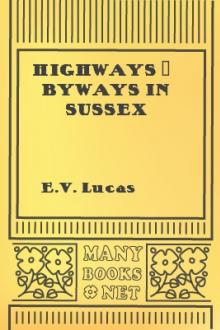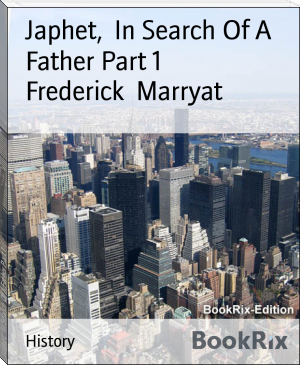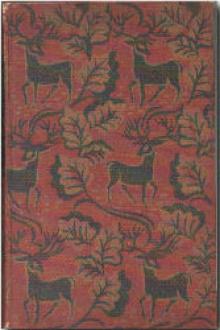Highways & Byways in Sussex by E. V. Lucas (e reader pdf best .txt) 📕

- Author: E. V. Lucas
- Performer: -
Book online «Highways & Byways in Sussex by E. V. Lucas (e reader pdf best .txt) 📕». Author E. V. Lucas
Following the Rother to the west one comes first to Easebourne, a shady cool village only a few steps from Midhurst, once notable for its Benedictine Priory of nuns. Henry VIII. put an end to its religious life, which, however, if we may believe the rather disgraceful revelations divulged at an episcopal examination, for some years had not been of too sincere a character. In Easebourne church is the handsome tomb of the first Viscount Montagu (the host of Queen Elizabeth), which was brought hither from Midhurst church some forty years ago. Beyond Easebourne, on the banks of the Rother, is Woolbeding, amid lush grass and foliage, as green a spot as any in green England.
On the eastern side of the town (with a diversion into Queen Elizabeth's sombre wood-walk) one may come by the side of the river part of the way to West Lavington, which stands high on a slope facing the Downs, with pine woods immediately beneath it, perhaps as fair a site as any church can claim. The grave of Richard Cobden, the Free Trader, a native of Heyshott, near by, is in the churchyard. Here, in 1850, Henry Edward Manning, afterwards Cardinal, preached his last sermon for the Church of England. It is, indeed, Manning country, for besides being curate and rector of Woollavington with Graffham (four or five miles to the south-east) from 1833 until his secession, he was for nine years Archdeacon of Chichester; he married Miss Sargent, daughter of the late rector and sister of Mrs. Samuel Wilberforce of Woollavington; and while rector, he rebuilt both churches. Graffham is interesting also as being the present home of one of the most truthful of living painters, Mr. Henry La Thangue, whose scenes of peasants at work (in the manner of Barbizon) and studies of sunlight spattering through the trees are among the triumphs of modern English art.
One more village and we will make for the hills. A mile beyond the eastern gate of Cowdray Park is Lodsworth, still a paradise of apple orchards, but no longer famous for its cider as once it was. Arthur Young had the pleasure of tasting some Lodsworth cider of a superior quality at Lord Egremont's table at the beginning of the last century, but I doubt if Petworth House honours the beverage to-day. Cider, except in the cider country, becomes less and less common.
Cowdray
Cowdray. CHAPTER III FIRST SIGHT OF THE DOWNSThe Sussex hills—Gilbert White's praise—Britons, Romans, Saxons—Charles the Second's ride through Sussex.
Between Midhurst and Chichester, our next centre, rise the Downs, to a height of between seven hundred and eight hundred feet. Although we shall often be crossing them again before we leave the county, I should like to speak of them a little in this place.
The Downs are the symbol of Sussex. The sea, the Weald, the heather hills of her great forest district, she shares with other counties, but the Downs are her own. Wiltshire, Berkshire, Kent and Hampshire, it is true, have also their turf-covered chalk hills, but the Sussex Downs are vaster, more remarkable, and more beautiful than these, with more individuality and charm. At first they have been known to disappoint the traveller, but one has only to live among them or near them, within the influence of their varying moods, and they surely conquer. They are the smoothest things in England, gigantic, rotund, easy; the eye rests upon their gentle contours and is at peace. They have no sublimity, no grandeur, only the most spacious repose. Perhaps it is due to this quality that the Wealden folk, accustomed to be overshadowed by this unruffled range, are so deliberate in their mental processes and so averse from speculation or experiment. There is a hypnotism of form: a rugged peak will alarm the mind where a billowy green undulation will lull it. The Downs change their complexion, but are never other than soothing and still: no stress of weather produces in them any of that sense of fatality that one is conscious of in Westmoreland. Thunder-clouds empurple the turf and blacken the hangers, but they cannot break the imperturbable equanimity of the line; rain throws over the range a gauze veil of added softness; a mist makes them more wonderful, unreal, romantic; snow brings them to one's doors. At sunrise they are magical, a background for Malory; at sunset they are the lovely home of the serenest thoughts, a spectacle for Marcus Aurelius. Their combes, or hollows, are then filled with purple shadow cast by the sinking sun, while the summits and shoulders are gold.
Gilbert White has an often-quoted passage on these hills:—"Though I have now travelled the Sussex downs upwards of thirty years, yet I still investigate that chain of majestic mountains with fresh admiration year by year, and I think I see new beauties every time I traverse it. This range, which runs from Chichester eastward as far as East Bourn, is about sixty miles in length, and is called the South Downs, properly speaking, only round Lewes. As you pass along you command a noble view of the wild, or weald, on one hand, and the broad downs and sea on the other. Mr. Ray used to visit a family [Mr. Courthope, of Danny] just at the foot of these hills, and was so ravished with the prospect from Plumpton Plain, near Lewes, that he mentions those scapes in his Wisdom of God in the Works of the Creation with the utmost satisfaction, and thinks them equal to anything he had seen in the finest parts of Europe. For my own part, I think there is somewhat peculiarly sweet and amusing in the shapely-figured aspect of the chalk hills in preference to those of stone, which are rugged, broken, abrupt, and shapeless. Perhaps I may be singular in my opinion, and not so happy as to convey to you the same idea; but I never contemplate these mountains without thinking I perceive somewhat analogous to growth in their gentle swellings and smooth fungus-like protuberances, their fluted sides, and regular hollows and slopes, that carry at once the air of vegetative dilatation and expansion:—Or, was there even a time when these immense masses of calcareous matter were thrown into fermentation by some adventitious moisture, were raised and leavened into such shapes by some plastic power; and so made to swell and heave their broad backs into the sky, so much above the less animated clay of the wild below?"
The Downs have a human and historic as well as scenic interest. On many of their highest points are the barrows or graves of our British ancestors, who, could they revisit the glimpses of the moon, would find little change, for these hills have been less interfered with than any district within twice the distance from London. The English dislike of climbing has saved them. They will probably be the last stronghold of the horse when petrol has ousted him from every other region.
After the Briton came the Roman, to whose orderly military mind such a chain of hills seemed a series of heaven-sent earthworks. Every point in a favourable position was at once fortified by the legionaries. Standing upon these ramparts to-day, identical in general configuration in spite of the intervening centuries, one may imagine one's self a Cæsarian soldier and see in fancy the hinds below running for safety.
After the Romans came the Saxons, who did not, however, use the heights as their predecessors had. Yet they left even more intimate traces, for, as I shall show in a later chapter on Sussex dialect, the language of the Sussex labourer is still largely theirs, the farms themselves often follow their original Saxon disposition, the field names are unaltered, and the character of the people is of the yellow-haired parent stock. Sussex, in many respects, is still Saxon. In a poem by Mr. W. G. Hole is a stanza which no one that knows Sussex can read without visualising instantly a Sussex hill-side farm:—
Standing on one of these hills above the Hartings one may remember an event in English history of more recent date than any of the periods that we have been recalling—the escape of Charles II in 1651. It was over these Downs that he passed; and it has been suggested that a traveller wishing for a picturesque route across the Downs might do well to follow his course.
According to the best accounts Charles was met, on the evening of October 13, near Hambledon, in Hampshire (afterwards to be famous as the cradle of first-class cricket), by Thomas and George Gunter of Racton, with a leash of greyhounds as if for coursing. The King slept at the house of Thomas Symonds, Gunter's brother-in-law, in the character of a Roundhead. The next morning at daybreak, the King, Lord Wilmot and the two Gunters crossed Broad Halfpenny Down (celebrated by Nyren), and proceeding by way of Catherington Down, Charlton Down, and Ibsworth Down, reached Compting Down in Sussex. At Stanstead House Thomas Gunter left the King, and hurried on to Brighton to arrange for the crossing to France. The others rode on by way of the hills, with a descent from Duncton Beacon, until they reached what promised to be the security of Houghton Forest. There they were panic-stricken nearly to meet Captain Morley, governor of Arundel Castle, and therefore by no means a King's man. The King, on being told who it was, replied merrily, "I did not much like his starched mouchates." This peril avoided, they descended to Houghton village, where the Arun was crossed, and so to Amberley, where in Sir John Briscoe's castle the King slept.[1]
On Amberley Mount the King's horse cast a shoe, necessitating a drop to one of the Burphams, at Lee Farm, to have the mishap put right. Ascending the hills again the fugitives held the high track as far as Steyning. At Bramber they survived a second meeting with Cromwellians, three or four soldiers of Col. Herbert Morley of Glynde suddenly appearing, but being satisfied merely to insult them. At Beeding, George Gunter rode on by way of the lower road to Brighton, while the King and Lord Wilmot climbed the hill at Horton, crossing by way of White Lot to Southwick, where, according to one story, in a cottage at the west of the Green was a hiding-hole in which the King lay until Captain Nicholas Tattersall of Brighton was ready to embark him for Fécamp. George Gunter's own story is, however, that the King rode direct to Brighton. He reached Fécamp on October 16. Two hours after Gunter left Brighton, "soldiers came thither to search for a tall black man, six feet four inches high"—to wit, the Merry Monarch.
Such is the bare narrative of Charles' Sussex ride. If the reader would have it garnished and spiced he should turn to the pages of Ainsworth's Ovingdean Grange, where much that never happened is set forth as entertainingly (or so I thought when I read it as a boy) as if it were truth.
[1] That is the story as the Amberley people like to have it, but another version makes him ride from Hambledon to





Comments (0)